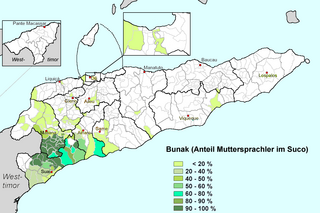Related Research Articles
Abau is a Papuan language spoken in southern Sandaun Province of Papua New Guinea, primarily along the border with Indonesia.
Tayap is an endangered Papuan language spoken by fewer than 50 people in Gapun village of Marienberg Rural LLG in East Sepik Province, Papua New Guinea. It is being replaced by the national language and lingua franca Tok Pisin.
Hiri Motu, also known as Police Motu, Pidgin Motu, or just Hiri, is a language of Papua New Guinea, which is spoken in surrounding areas of Port Moresby.

Stephen Adolphe Wurm was a Hungarian-born Australian linguist.

The Arapesh languages are several closely related Torricelli languages of the 32,000 Arapesh people of Papua New Guinea. They are spoken in eastern Sandaun Province and northern East Sepik Province, Papua New Guinea.
The Yuat languages are an independent family of five Papuan languages spoken along the Yuat River in East Sepik Province, Papua New Guinea. They are an independent family in the classification of Malcolm Ross, but are included in Stephen Wurm's Sepik–Ramu proposal. However, Foley and Ross could find no lexical or morphological evidence that they are related to the Sepik or Ramu languages.
Sulka is a language isolate of New Britain, Papua New Guinea. In 1991, there were 2,500 speakers in eastern Pomio District, East New Britain Province. Villages include Guma in East Pomio Rural LLG. With such a low population of speakers, this language is considered to be endangered. Sulka speakers had originally migrated to East New Britain from New Ireland.

The Bunak language is the language of the Bunak people of the mountainous region of central Timor, split between the political boundary between West Timor, Indonesia, particularly in Lamaknen District and East Timor. It is one of the few on Timor which is not an Austronesian language, but rather a Papuan language of the Timor-Alor-Pantar language family. The language is surrounded by Malayo-Polynesian languages, like Uab Meto and Tetum.

Oksapmin is a Trans–New Guinea language spoken in Oksapmin Rural LLG, Telefomin District, Sandaun, Papua New Guinea. The two principal dialects are distinct enough to cause some problems with mutual intelligibility.
Woi (Wooi) is a Malayo-Polynesian language of Papua, Indonesia mainly spoken in the villages of Wooi and Woinap on Yapen Island and the village of Yenuari on Moisnum Island.

The Alor–Pantar languages are a family of clearly related Papuan languages spoken on islands of the Alor archipelago near Timor in southern Indonesia. They may be most closely related to the Papuan languages of eastern Timor, but this is not yet clear. A more distant relationship with the Trans–New Guinea languages of the Bomberai peninsula of Western New Guinea has been proposed based on pronominal evidence, but though often cited has never been firmly established.

The Yam languages, also known as the Morehead River languages, are a family of Papuan languages. They include many of the languages south and west of the Fly River in Papua New Guinea and Indonesian West Papua.
Kaki Ae, or Tate, is a language with about 500 speakers, half the ethnic population, near Kerema, in Papua New Guinea. It was previously known by the foreign designation Raeta Tati.
Awtuw (Autu), also known as Kamnum, is spoken in Sandaun Province, Papua New Guinea. It is a polysynthetic language closely related to Karawa and Pouye. It is spoken in Galkutua, Gutaiya, Kamnom, Tubum, and Wiup villages in Kamnom East ward, East Wapei Rural LLG, Sandaun Province.
Karas is a divergent Trans–New Guinea language spoken on the biggest of the Karas Islands off the Bomberai Peninsula, that appears to be most closely related to the West Bomberai languages. It is spoken in Antalisa and Mas villages on Karas Island.
Kwomtari is the eponymous language of the Kwomtari family of Papua New Guinea.
Sinasina is a term used to refer to for several Chimbu–Wahgi language varieties of Tabare Rural LLG, Simbu Province, Papua New Guinea. The term 'Sinasina' as a language name is an exonym. Speakers of the varieties of this region instead refer to their languages with tok ples vernacular languages endonyms, including: Dinga, Gunangi, Kebai, Kere, Kondo, Nimai, Tabare. The Kere community also has a deaf sign language, Sinasina Sign Language.
Dom is a Trans–New Guinea language of the Eastern Group of the Chimbu family, spoken in the Gumine and Sinasina Districts of Chimbu Province and in some other isolated settlements in the western highlands of Papua New Guinea.
Papapana is an Austronesian language of Bougainville, Papua New Guinea.

Baluan-Pam is an Oceanic language of Manus Province, Papua New Guinea. It is spoken on Baluan Island and on nearby Pam Island. The number of speakers, according to the latest estimate based on the 2000 Census, is 2,000. Speakers on Baluan Island prefer to refer to their language with its native name Paluai.
References
- 1 2 Kesawai at Ethnologue (25th ed., 2022)
